You have to admit, root vegetables can be a bizarre-looking lot.
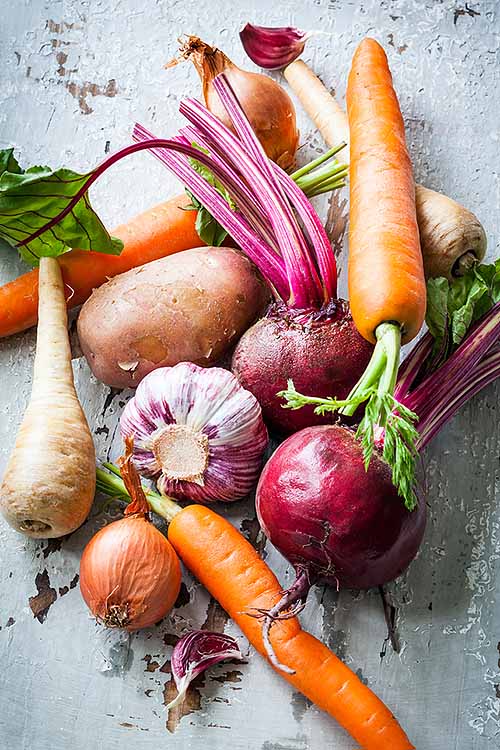
And with their knobby shapes and thick, scruffy skins, it’s not much of a surprise that they don’t often get the appreciation they deserve.
This is really a shame, because they’re nutritional powerhouses with a treasure trove of vitamins, minerals, and healthy phytonutrients that make them a worthy addition to any menu.
Though they can be bland when steamed or boiled, roasting brings out rich, complex flavors that you’ll fall in love with!
Plus, they’re readily available in the winter when other veggies are scarce, and for the most part, they’re inexpensive as well.
With all of these points in their favor, let’s dig in to the best ways to prepare root vegetables for fabulous roasted results!
Why the Weird Shapes?
Root veggies can look a bit intimidating to the uninitiated. But the truth is, these large, bulbous roots are actually storage organs for plants – they contain energy in the form of carbohydrates.
Perennial in nature, these plants need an ample supply of stored nutrients to handle adverse conditions such as winter cold, drought, or extreme heat. Without it, they won’t survive until the next season – hence the large size of these organs compared to their leafy topsides.
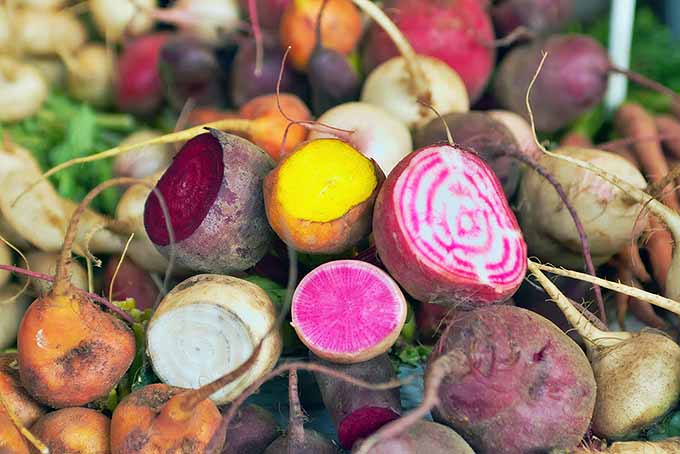
This cache of energy is maximized when one leaf-growing season ends, but before the next season’s new growth appears – which is when they’re typically harvested.
And because they live underground as roots, they can twist and form into odd shapes as they seek out the richest pockets and seams of nutrients.
Roasting for Sweetness
The flavor of all vegetables will change when they are roasted, but root veggies take on a whole new level of sweet and nutty flavors thanks to caramelization, the oxidization of natural sugars.
At high temperatures, the sugars break down as water is removed, which transforms into a distinctive amber color, rich flavor, and glazed texture.

There’s a fine line between caramelization and carbonization… and you don’t want to cross it, or your lovely veggies will turn into lumps of coal!
Most recipes call for temps between 375 and 425°F, but do take into consideration the size of the pieces you’re roasting, and your oven’s unique traits.
Very large pieces take longer to cook, and at high temperatures, the exterior can burn before the inside is tender – so cut all pieces to a uniform size and thickness for even cooking.
Consider the Area
The other main consideration for caramelization is surface area. The greater the surface area that contacts the roasting pan or hot air, the more caramelization will occur.
This means the way you cut your veggies will also have an impact.
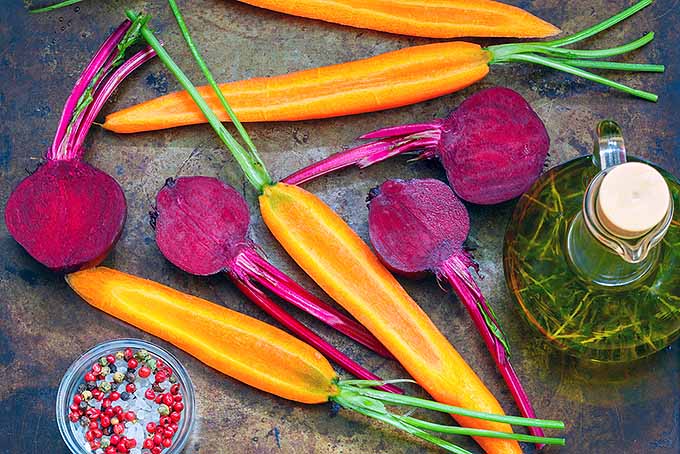
For a golden outcome, use rectangular, diagonal, or triangular cuts – these will give more surface area than small cube shapes.
Carrots and parsnips can be cut diagonally, or halved or quartered lengthwise.
Use whole garlic cloves, skin and all, with the just the top tips sliced off.
Trim the root and stem ends of peeled onions, then cut horizontally into halves or thirds, using the same thickness as the rest of the ingredients.
The remaining root veggies like potatoes, yams, turnips, rutabagas, kohlrabi, celery root, and so on can all be cut into slats or thick dominoes to maximize surface exposure.
Speaking of area, it’s also important to give your veggies adequate space in the roasting pan.
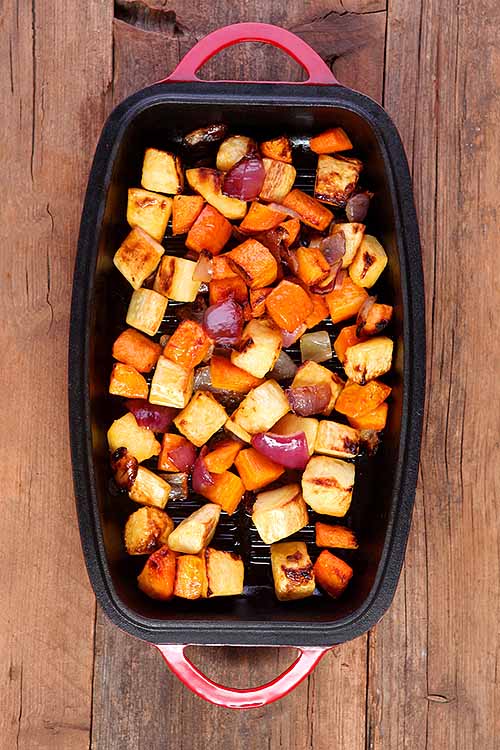
You want them to roast, not steam, and crowded veggies will steam in their own juices. Whatever type of pan you use, arrange pieces in a single layer, not piled on top of each other – and give a bit of breathing room between pieces as well.
Use two pans if need be, and switch the position of the pans on your oven racks halfway through cooking.
The Kitchen Lab
One of the most fun aspects of root vegetables is their great versatility for experimenting with flavors.
To the standard fare of potatoes, carrots, sweet potatoes or yams, onions, and garlic, try mixing in some turnips, beets, parsnips, Jerusalem artichokes, kohlrabi, or rutabaga.
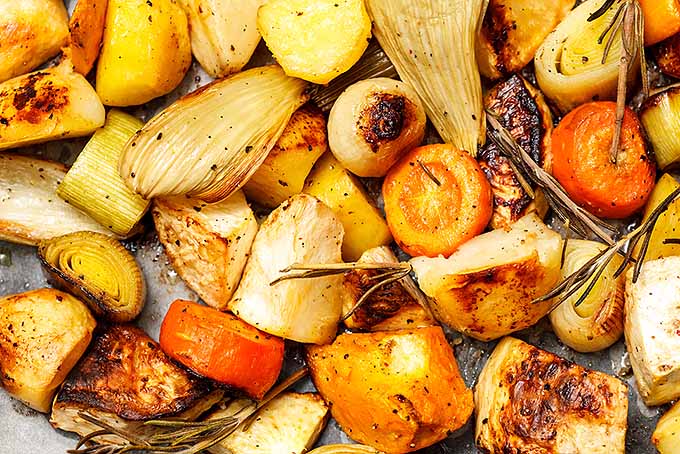
Since there are no hard and fast rules for roasted veggies, produce grown above ground can also be added to the medley.
Winter squash is a fab addition, and most vegetables (with the exception of leafy greens) will roast with tasty results.
Broccoli, cauliflower, asparagus, green beans, mushrooms, peppers, tomatoes, and so on can all be used – but keep in mind their difference in cooking times and add these after the thicker veggies have had a head start.
Try our recipe for asparagus with walnut crema and pecorino to get a taste of some roasted deliciousness with a different vegetable.
Along with a hot oven and adequate space on your baking tray, the remaining requirements are minimal. All you need is a drizzle of your favorite vegetable oil to prevent burning and add a bit of flavor, plus some salt and freshly ground black pepper.
A tablespoon of balsamic vinegar or broth, and some fresh herbs make nice flavor additions as well. Or you can add some heat with a sprinkle of warming spices like cayenne, cinnamon, or cumin.
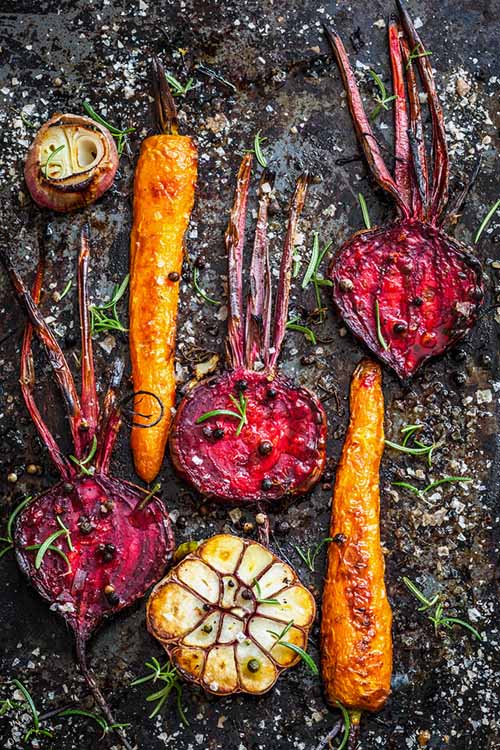
For a beautiful caramelized glaze and sweet, mellow flavors, toss your prepped veggies with the oil and seasonings, and spread out evenly on a baking tray. Roast for 1-1 1/4 hours at 400°F (or less, depending on size and density), stirring occasionally.
These can also be prepared a few hours ahead of time and served at room temperature or reheated at mealtime.
Picking and Storing
As with all vegetables, the flavor of root veggies is best when fresh, firm produce is chosen. Avoid any roots that have soft spots, skin blemishes, or soft, wrinkly skin.

Most will require cool, slightly damp storage making the fridge the ideal place to keep them – if you don’t have a root cellar. The exceptions to storing in the fridge are potatoes, onions, and garlic.
These veggies like a dry, cool, but not cold location out of direct light. Potatoes are best in a paper bag as plastic ones can cause rot.
Onions and garlic like some ventilation, so a basket is a good choice. And don’t store potatoes with onions as the spuds give off moisture and gases that can cause the onions to spoil.
Putting a Fork in It
And that, folks, is the magic of roasting vegetables. The outcome is a sweeter, more deeply flavored morsel with a hint of nuttiness.
If you’re primed to get cooking (or more accurately, roasting!) make sure to give our roasted rosemary carrots with honey glaze recipe a taste.
Easy to prepare, they’re a great way to top up on your daily veggie quota – and even those who don’t like vegetables will be smitten with the taste!
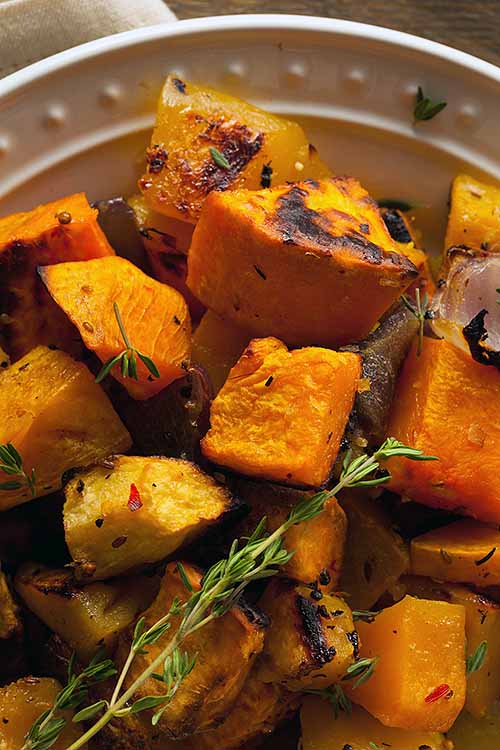
Choose the flavors that appeal to you most, cut to an appropriate size for caramelization, season and toss with oil, then cook in a blazing hot oven. You’ll love the rich results!
How about you readers, do you have any tips or suggestions for roasting root veggies to pass along? Leave us a note in the comments below – we’d love to hear from you!
Photo credits: Shutterstock, except where otherwise credited.
About Lorna Kring
Recently retired as a costume specialist in the TV and film industry, Lorna now enjoys blogging on contemporary lifestyle themes. A bit daft about the garden, she’s particularly obsessed with organic tomatoes and herbs, and delights in breaking bread with family and friends.




Veggies can actually one of the main attractions of the meal if you just do things right. Roasting is usually a good way to go, and I personally liked them to be a little more charred and crispy so I tend to go on the longer side, but that is just me and you can make them how you like. Carrots are my favorite.
A touch of char’s not a bad thing! Thanks for your thoughts rz.